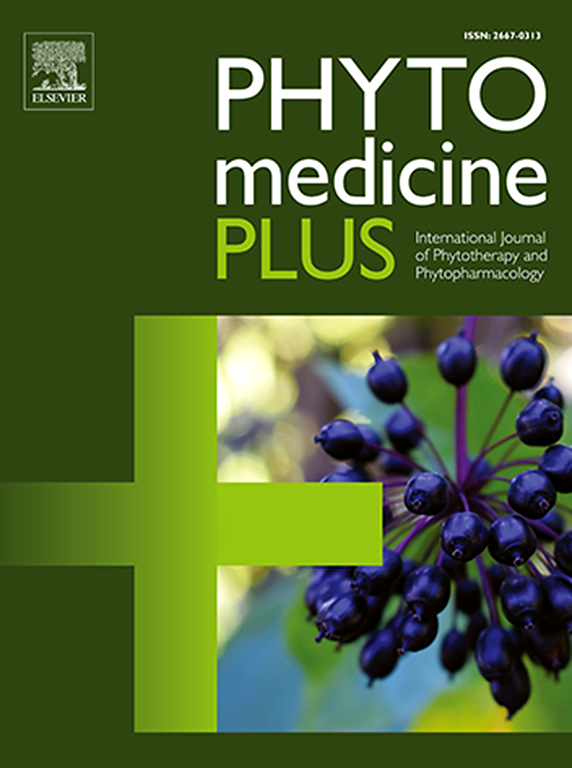Anti-atherosclerotic effects of combined Bambusa bambos (L.) Voss and Ananas comosus (L.) Merr. extract on hypercholesterolemic rabbits
Q3 Pharmacology, Toxicology and Pharmaceutics
引用次数: 0
Abstract
Background
Atherosclerosis, a chronic inflammatory disease characterized by lipid accumulation and plaque formation in arterial walls, remains a leading cause of cardiovascular morbidity and mortality worldwide, with current treatments limited by side effects and incomplete effectiveness.
Purpose
This study evaluated the anti-atherosclerotic and antioxidant properties of a traditional Vietnamese herbal extract named as “CDT-based extract” (CDT) containing Bambusa bambos (L.) Voss and Ananas comosus (L.) Merr. in a diet-induced atherosclerosis model.
Methods
New Zealand White rabbits were fed a high-fat diet (HFD) containing cholesterol and peanut oil for 10 weeks, along with either distilled water (HFD control), atorvastatin (2.4 mg/kg, positive control), or CDT at doses of 0.3 and 0.6 g/kg/day. Blood samples were collected at baseline and week 10 for biochemical, antioxidant, and inflammatory markers analysis. Aortic and hepatic tissues underwent gross and microscopic assessment.
Results
CDT treatment significantly reduced total cholesterol and low-density lipoprotein cholesterol at both doses, while triglycerides were significantly reduced only at 0.6 g/kg/day. Histological examination revealed that CDT reduced atherosclerotic lesion areas and plaque formation compared to the HFD control. Both CDT doses decreased AST, ALT, and bilirubin levels without affecting albumin concentrations. CDT enhanced antioxidant status by increasing superoxide dismutase, nitric oxide, and glutathione peroxidase activities while decreasing malondialdehyde, lactate dehydrogenase, and tumor necrosis factor-alpha levels.
Conclusion
These findings suggest CDT exhibits anti-atherosclerotic properties through its antioxidant and lipid-lowering effects.
复方竹笋的抗动脉粥样硬化作用沃斯和阿纳斯·科莫苏斯(L.)稳定。提取物对高胆固醇血症家兔的作用
动脉粥样硬化是一种慢性炎症性疾病,其特征是动脉壁上的脂质积累和斑块形成,是全球心血管疾病发病率和死亡率的主要原因,目前的治疗受到副作用和不完全疗效的限制。目的:研究越南传统草药竹基提取物(CDT)的抗动脉粥样硬化和抗氧化性能。沃斯和阿纳斯·科莫苏斯(L.)稳定。在饮食诱导的动脉粥样硬化模型中方法采用高脂饲粮(HFD)喂养新西兰大白兔10周,同时饲喂蒸馏水(HFD对照)、阿托伐他汀(2.4 mg/kg,阳性对照)或CDT(0.3和0.6 g/kg/d)。在基线和第10周采集血样进行生化、抗氧化和炎症标志物分析。主动脉和肝组织进行大体和显微镜检查。结果scdt治疗在两种剂量下均显著降低了总胆固醇和低密度脂蛋白胆固醇,而甘油三酯仅在0.6 g/kg/d时显著降低。组织学检查显示,与HFD对照组相比,CDT减少了动脉粥样硬化病变面积和斑块形成。两种CDT剂量均可降低AST、ALT和胆红素水平,而不影响白蛋白浓度。CDT通过增加超氧化物歧化酶、一氧化氮和谷胱甘肽过氧化物酶活性,同时降低丙二醛、乳酸脱氢酶和肿瘤坏死因子- α水平,增强抗氧化状态。结论CDT具有抗动脉粥样硬化和降脂作用。
本文章由计算机程序翻译,如有差异,请以英文原文为准。
求助全文
约1分钟内获得全文
求助全文
来源期刊

Phytomedicine Plus
Medicine-Complementary and Alternative Medicine
CiteScore
3.70
自引率
0.00%
发文量
178
审稿时长
81 days
期刊介绍:
 求助内容:
求助内容: 应助结果提醒方式:
应助结果提醒方式:


